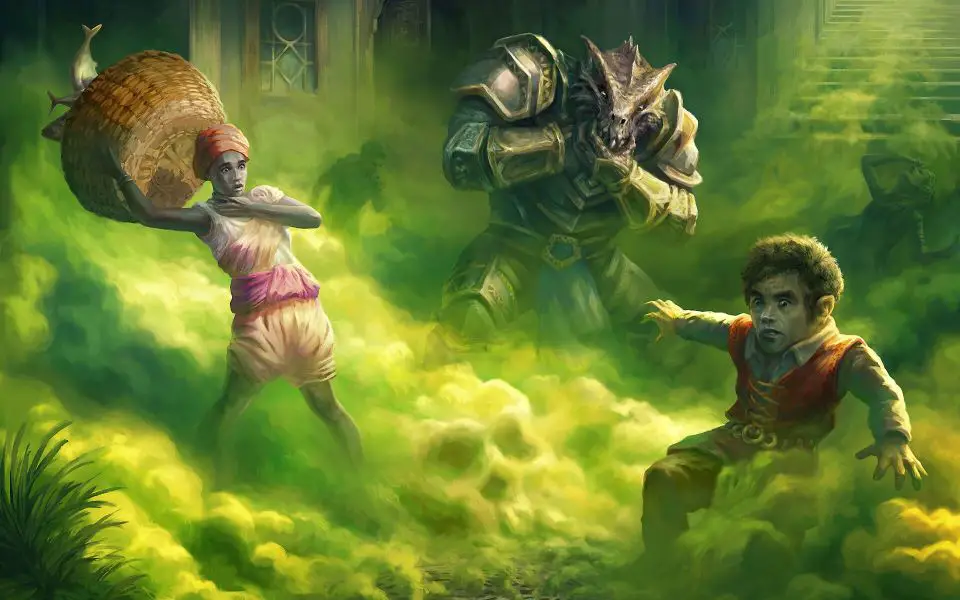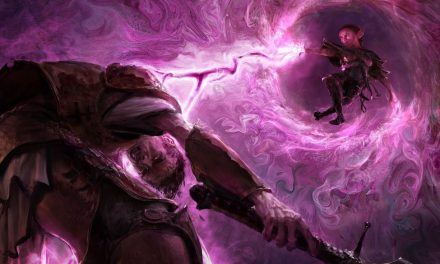Today we take a deep dive into one of D&D 5e’s most intriguing and potent spells: Cloudkill.
This spell, with its ominous name and even more sinister effects, has long been a favorite among those who wield arcane power. Whether you’re a cunning Sorcerer, a studious Wizard, or a pact-making Warlock, Cloudkill offers a unique blend of area control and devastating damage that can turn the tide of any battle.
In this article, we’ll unravel the mysteries of Cloudkill, exploring its mechanics, strategic uses, and the delicate balance of its strengths and weaknesses.
By the end, you’ll not only understand how to cast this spell effectively but also how to integrate it seamlessly into your adventuring toolkit.
So grab your spellbook, strap on that gas mask, and let’s conjure up some knowledge about this deadly fog!
What is Cloudkill 5e?
Cloudkill is a 5th-level conjuration spell that summons a 20-foot-radius sphere of poisonous, yellow-green fog. Cast within a range of 120 feet, this noxious cloud lingers and spreads around corners, creating a heavily obscured area.
Any creature that enters or starts its turn in the fog must make a Constitution saving throw, taking a whopping 5d8 poison damage on a failed save or half as much on a successful one. The fog moves 10 feet away from you at the start of each of your turns, rolling along the ground and sinking to the lowest levels.
This spell is perfect for area control and disrupting enemy formations, but be careful—it requires concentration and can affect allies as well as foes!
LEVEL: 5th
CASTING TIME: 1 Action
RANGE/AREA: 120 ft (20-foot radius sphere)
COMPONENTS: V, S
DURATION: 10 minutes, Concentration required
SCHOOL: Conjuration
ATTACK/SAVE: Constitution Saving Throw
DAMAGE/EFFECT: Poison
SPELL LISTS: Sorcerer, Wizard, Artificer (Alchemist), Cleric (Death Domain), Druid (Circle of the Land and Circle of Spores), Paladin (Oath of Conquest), Warlock (The Undead Patron)
You create a 20-foot-radius sphere of poisonous, yellow-green fog centered on a point you choose within range. The fog spreads around corners. It lasts for the duration or until strong wind disperses the fog, ending the spell. Its area is heavily obscured.
When a creature enters the spell’s area for the first time on a turn or starts its turn there, that creature must make a Constitution saving throw. The creature takes 5d8 poison damage on a failed save, or half as much damage on a successful one. Creatures are affected even if they hold their breath or don’t need to breathe.
The fog moves 10 feet away from you at the start of each of your turns, rolling along the surface of the ground. The vapors, being heavier than air, sink to the lowest level of the land, even pouring down openings.
At Higher Levels. When you cast this spell using a spell slot of 6th level or higher, the damage increases by 1d8 for each slot level above 5th.

How to Use Cloudkill 5e Effectively
Harnessing the full potential of Cloudkill requires strategic thinking and a bit of cunning. You don’t want to cast this spell unless you have a clear plan!
Here’s how to make the most out of this deadly fog:
Preparation and Casting
As with most AoE spells, timing truly is everything.
Cast Cloudkill when enemies are clustered together or in confined spaces where the fog can wreak maximum havoc. Ideal moments include when foes are bottlenecked in a narrow corridor or trapped in an enclosed area.
Before casting, consider the battlefield layout and potential movements of your enemies.
You want to coordinate with your party to use spells or abilities that can bunch up and/or trap enemies, such as Wall of Force or Entangle, to maximize the number of targets within the fog’s area of effect.
Tactical Uses
Cloudkill excels at battlefield control. Any enemy that wants to brave the path through the cloud will be doing so at a high cost of their hit points!
Use this spell to block off escape routes or force enemies into disadvantageous positions. For instance, casting Cloudkill at a choke point can prevent enemies from advancing or retreating without taking significant damage.
As mentioned, you can also pair it with spells like Wall of Force to trap enemies in the toxic cloud, or use it to cover a retreat, creating a deadly barrier between you and pursuing foes.
And don’t neglect the fog’s ability to spread around corners! This means you can affect enemies hiding behind cover or in adjacent rooms, adding a layer of unpredictability to your strategy.
Positioning and Movement
Remember, the fog moves 10 feet away from you each turn. Use this to your advantage by positioning yourself strategically to guide the cloud toward enemy lines.
This movement can also help you clear out areas or disrupt enemy formations.
For example, if enemies are advancing towards you, cast Cloudkill and then move backward, leading the fog into their path. Alternatively, if you need to protect a specific area, position yourself so the fog moves in a way that covers the most ground and affects the highest number of enemies.
By understanding when and where to deploy Cloudkill, you can turn the tide of battle, creating chaos and dealing significant damage to your enemies.
Just be mindful of your allies and the spell’s concentration requirement to avoid any unintended consequences!
Pros and Cons of Cloudkill 5e
Like any powerful spell, Cloudkill comes with its own set of advantages and drawbacks. Knowing these can help you decide when to unleash this toxic tempest and when to hold back.
Pros
- High Damage Potential: With a hefty 5d8 poison damage per round, Cloudkill can quickly whittle down the health of even the toughest foes. Those in the area of effect will quickly be scrambling to get out of it.
- Area Control: The 20-foot-radius sphere can cover a large area, making it perfect for controlling the battlefield and forcing enemies to move or take damage. Used strategically, it can be downright cruel!
- Long Duration: Lasting up to 10 minutes with concentration, Cloudkill can persist through multiple rounds of combat, continuously pressuring your opponents.
- Versatility: The fog moves 10 feet away from you each turn, allowing you to guide it strategically across the battlefield, affecting new targets each round. Be tactical with your casting to make sure you keep the pressure up on your enemies!
Cons
- Concentration Required: Cloudkill demands your concentration, meaning you can’t cast other concentration spells simultaneously. Additionally, you risk losing the spell if you take damage, so make sure you’re casting from a safe place!
- Friendly Fire: In the heat of battle, it’s easy for allies to accidentally wander into the fog, suffering the same toxic effects as your enemies. This spell doesn’t tell the difference between friend and foe!
- Limited Against Poison-Resistant Creatures: Many creatures, especially undead and constructs, are resistant or immune to poison damage, significantly reducing the spell’s effectiveness against them.
- Environmental Dependency: Strong winds can disperse the fog, ending the spell prematurely and wasting your precious spell slot. Casting in a closed space or otherwise stagnant area will be much better than, say, casting it on the deck of a ship.
By weighing these pros and cons, you can better decide when to deploy Cloudkill to maximize its effectiveness and minimize its risks. This spell can be a game-changer in your magical arsenal with some careful planning and strategic use!

FAQs – Cloudkill 5e
Cloudkill’s fog spreads around corners but does not move through solid walls or barriers. It can, however, seep through openings, cracks, and other gaps, potentially reaching enemies hiding behind cover or in adjacent rooms.
Yes, Cloudkill affects creatures even if they hold their breath or don’t need to breathe. The spell’s toxic nature transcends simple inhalation, ensuring that all within its radius feel its deadly touch.
Absolutely! Cloudkill can be particularly devastating indoors, where the fog has limited space to disperse and can quickly fill enclosed areas. Just remember that the fog will sink to the lowest level, so it might pour down staircases or through openings.
If a strong wind disperses the fog, the spell ends immediately. This means that environmental factors or abilities that create strong winds can prematurely cut short your Cloudkill, so be mindful of your surroundings when casting it.
Cloudkill can be combined with other area-of-effect spells to devastating effect. For instance, casting Wall of Force to trap enemies inside the fog ensures they remain within its toxic grasp longer. Similarly, pairing it with spells like Stinking Cloud or Web can immobilize foes, maximizing their exposure to the poison.
Conclusion – Cloudkill 5e
And there you have it, adventurers—a comprehensive guide to mastering the deadly art of Cloudkill in D&D 5e.
From its high damage potential and battlefield control to its strategic applications and inherent risks, Cloudkill is a spell that, when used wisely, can turn the tide of any encounter.
Whether you’re a Sorcerer, Wizard, or any other class that can cast it, this spell offers a potent mix of versatility and power that’s hard to ignore.
I hope this guide has equipped you with the knowledge and confidence to successfully unleash Cloudkill in your next campaign.
But the adventure doesn’t stop here! We’d love to hear about your own experiences and strategies with Cloudkill. Have you used it to devastating effect, or perhaps encountered some unexpected challenges? Share your stories and tips in the comments below!
And if you enjoyed this article, why not stay in the loop with all things D&D?
Sign up for the Tabletop Joab newsletter to get more spell guides, gameplay tips, and other great content delivered straight to your inbox. Join our community of passionate gamers and keep your spellbook—and your adventures—ever-expanding.
Until next time, may your rolls be high and your enemies be engulfed in a cloud of defeat!









